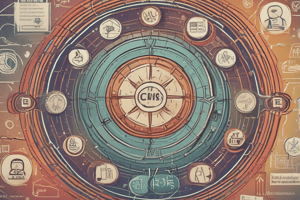Podcast
Questions and Answers
What is the main task of top management in relation to organizational growth stages?
What is the main task of top management in relation to organizational growth stages?
To be aware of the stages of development within the organization.
What should top leaders be cautious about when navigating organizational growth phases?
What should top leaders be cautious about when navigating organizational growth phases?
- Imposing the wrong solution (correct)
- Working against the flow of the tide
- Skipping phases out of impatience (correct)
- Recognizing too many solutions
Solutions implemented by managers in an organization can lead to future problems.
Solutions implemented by managers in an organization can lead to future problems.
True (A)
Managers should be in a position to predict future problems and prepare __________ and coping strategies before a revolution gets out of hand.
Managers should be in a position to predict future problems and prepare __________ and coping strategies before a revolution gets out of hand.
Match the management guideline with its description:
Match the management guideline with its description:
Flashcards are hidden until you start studying
Study Notes
Evolution and Revolution in Organizational Growth
- The evolution of an organization is shaped by its history, and management's inability to understand its organization development problems can lead to failure or stagnation.
- The concept of evolution refers to prolonged periods of growth without major upheaval, while revolution refers to periods of substantial turmoil in organization life.
- Each evolutionary period creates its own revolution, and management's solution to each revolution determines the next stage of evolutionary growth.
Key Forces in Development
- Five key dimensions of organization development:
- Age of the organization
- Size of the organization
- Stages of evolution
- Stages of revolution
- Growth rate of the industry
- These dimensions interact and influence each other over time, creating a dynamic picture of organizational growth.
Phases of Growth
- Phase 1: Creativity and the Leadership Crisis
- Characteristics: emphasis on creating a product and market, founders disdain management activities, informal communication, and control through marketplace feedback.
- Crisis: leadership crisis, need for strong business manager to introduce new business techniques.
- Phase 2: Direction and the Autonomy Crisis
- Characteristics: functional organization structure, formal communication, and incentives.
- Crisis: demands for greater autonomy from lower-level managers, solution is to move towards greater delegation.
- Phase 3: Delegation and the Control Crisis
- Characteristics: decentralized organization structure, profit centers, and bonuses.
- Crisis: top executives sense loss of control, decentralized managers develop parochial attitudes, solution is to use special coordination techniques.
- Phase 4: Coordination and the Red Tape Crisis
- Characteristics: formal systems for coordination, top executives take responsibility for initiation and administration of new systems.
- Crisis: lack of confidence between line and staff, and between headquarters and the field, proliferation of systems and programs exceeds utility, solution is to find a balance between coordination and autonomy.
Common Themes
- Each phase is both an effect of the previous phase and a cause for the next phase.
- Management actions are narrowly prescribed if growth is to occur.
- Revolutions seem to be more severe and difficult to resolve when the market environment is poor.
- Companies that fail to adapt to changing circumstances are likely to fail or level off in their growth rates.### Phase 5: Collaboration
- Emphasizes strong interpersonal collaboration to overcome the red-tape crisis.
- Characterized by spontaneity in management action through teams and skillful confrontation of interpersonal differences.
- Social control and self-discipline take over from formal control.
Characteristics of Phase 5
- Focus on solving problems quickly through team action.
- Teams are combined across functions for task-group activity.
- Headquarters staff experts are reduced in number, reassigned, and combined in interdisciplinary teams.
- Matrix-type structure is frequently used to assemble the right teams for the appropriate problems.
- Previous formal systems are simplified and combined into single multipurpose systems.
- Conferences of key managers are held frequently to focus on major problem issues.
- Educational programs are utilized to train managers in behavioral skills for achieving better teamwork and conflict resolution.
- Real-time information systems are integrated into daily decision making.
- Economic rewards are geared more to team performance than to individual achievement.
- Experiments in new practices are encouraged throughout the organization.
The Crisis and Revolution
- The crisis in Phase 5 revolves around the "psychological saturation" of employees.
- Solution to this crisis may involve new structures and programs that allow employees to periodically rest, reflect, and revitalize themselves.
- Examples of such solutions include providing sabbaticals, moving managers in and out of "hot spot" jobs, establishing a four-day workweek, and building physical facilities for relaxation.
Implications of History
- The main features of each growth phase are depicted in Exhibit III.
- Practicing managers should know where they are in the developmental sequence.
- Top leaders should be ready to work with the flow of the tide rather than against it.
- Managers should recognize the limited range of solutions in each revolutionary stage.
- Evolution is not an automatic affair; it is a contest for survival.
- Solutions breed new problems, and managers should be aware of this effect.
Management Guidelines
- Be aware of the stages of development in the organization.
- Recognize the limited range of solutions in each revolutionary stage.
- Be prepared to dismantle current structures before the revolutionary stage becomes too turbulent.
- Realize that solutions breed new problems, and be aware of this effect.
- Introduce planned structures that are solutions to a current crisis and fitted to the next phase of growth.
Studying That Suits You
Use AI to generate personalized quizzes and flashcards to suit your learning preferences.




